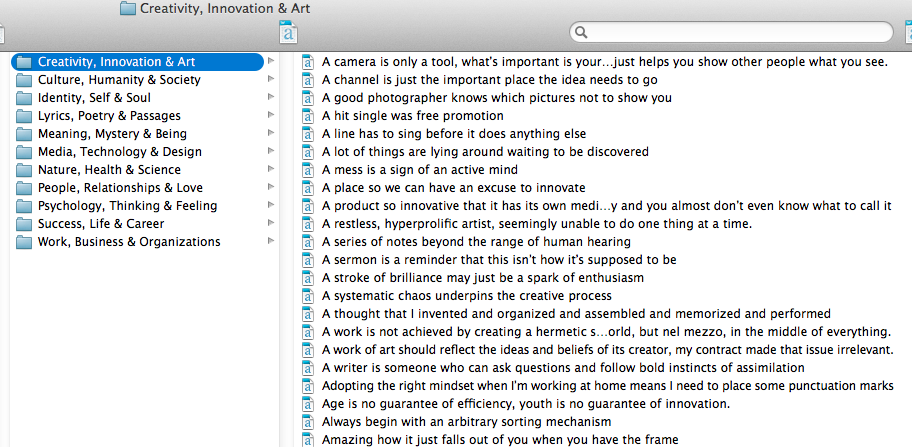

In the early stages of creation, the goal is to get your
ideas to ground zero.
To offload all of the raw materials so they can be processed
to their rightful inventory location. Cognitively, this closes the open loops
in your mind and keeps your brain from nagging and freaking out about losing or
forgetting them.
But once that phase is done, let the production begin.
What’s interesting is, the next stage of creation is the
opposite. Production, the ongoing activity of crafting new ideas, is fluid
experience. It’s a living, breathing, evolving organism that exists on neverending
artistic continuum, with no finish line in site and no constraint of
completion.
But like any good foreman, you still have to walk the
factory floor. On a routine basis,
you have to take a casual, curious and thoughtful sweep of every idea you’ve
recently accumulated. Otherwise you
lose track and overlook the quality of your inventory.
In my
inventory system, all of my ideas are organized into several different
categories, aka, compartments of life that are meaningful to me:
1.
Creativity,
Innovation & Art
2.
Culture,
Humanity & Society
3.
Identity,
Self & Soul
4.
Lyrics,
Poetry & Passages
5.
Meaning,
Mystery & Being
6.
Media,
Technology & Design
7.
Nature,
Health & Science
8.
People,
Relationships & Love
9.
Psychology,
Thinking & Feeling
10. Success, Life & Career
11. Work, Business &
Organizations
Inside
each folder are hundreds and sometimes thousands of ideas that I’ve inhaled
from a multitude of inspiration sources. Most of the documents are nothing but a
single sentence, although some ideas are more fleshed out than others.
The
ideas are sorted in a couple of ways:
First, chronologically,
which allows me see which ideas were created on which day. This organizing
principle allows me to see fluctuations in my inspiration. For example, if I
notice twenty ideas from one day but only six on another, I can reverse
engineer my inhaling process to find patterns in my life that produced such
results.
Second, alphabetically, which allows an arbitrary overview of my
ideas. This organizing principle allows me to see patterns in my inspiration.
For example, if I notice a collection of eight ideas that start with the same word or
phrase, I can use that as inspiration for a larger module.
Thanks to these sorting mechanisms, each time I walk the factory floor, I open
the various folders of ideas and just let the language wash over me as the serendipitous
construction and collection of words massage my brain.
And something magical
happens.
It’s called distributed
cognition.
Creativity researchers discovered this psychological
process, whereby new ideas arise from combining many disparate pieces of
information or concepts over an extended period of time. Turns out, visualizing
a large volume of content creates a mechanism to hold your ideas and continually
reflect them back to you in an objective, reviewable format. Which, in turn,
helps you generate new ideas that may not have occurred to you otherwise.
Like iron filling drawn to a magnet.
George Carlin was a master of distributed cognition. Not
just because he took a lot of acid in the sixties, but also because he made a
habit of walking the factory floor. He once remarked that he was “blessed with some pretty deep files. His creative inventory was clearly a deep source of
pride for him.
During one of his longer interviews, he painted a vivid
picture of how distributed cognition worked in his process:
“With my files, every time you see it, touch it, look at it
or think about it, it gets deeper in the brain, the network gets deeper, and at
some point, it gets to be a telling mass that says to you, okay you’ve got
enough data, take a look at this now.”
He’s not writing, he’s listening for what wants to be
written.
Carlin proves that production truly is an open loop. Unlike
processing, where the goal is to close the loop and finish the task and get the
idea out of your head and into a folder, production is neverending. These ideas, theseuncompleted
tasks and unmet goals, tend to pop in your mind. And because they’re always
growing,your brain treats them as unfinished business, as if to keep
reminding you that there is a job to be done. That’s why your mind keeps
inserting bits of the idea into your stream of thought.
You’re not working on material, the material is working on you.
If you want to become a more prolific creator, I challenge you to create this kind of ritual. Casually, curiously and thoughtfully sweeping every idea you’ve recently accumulated.
You’ll find that walking the factory floor has a
profound effect on production.
